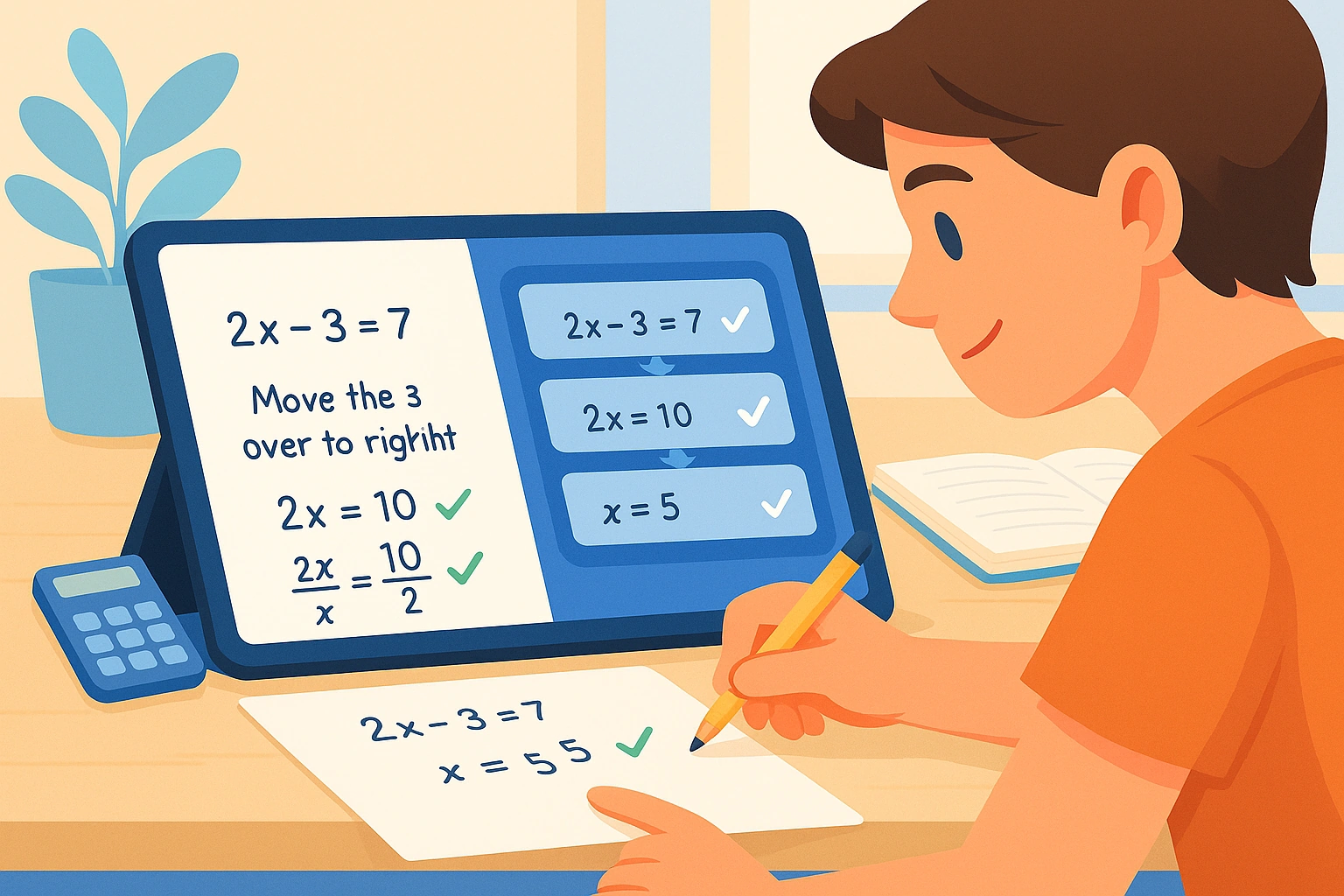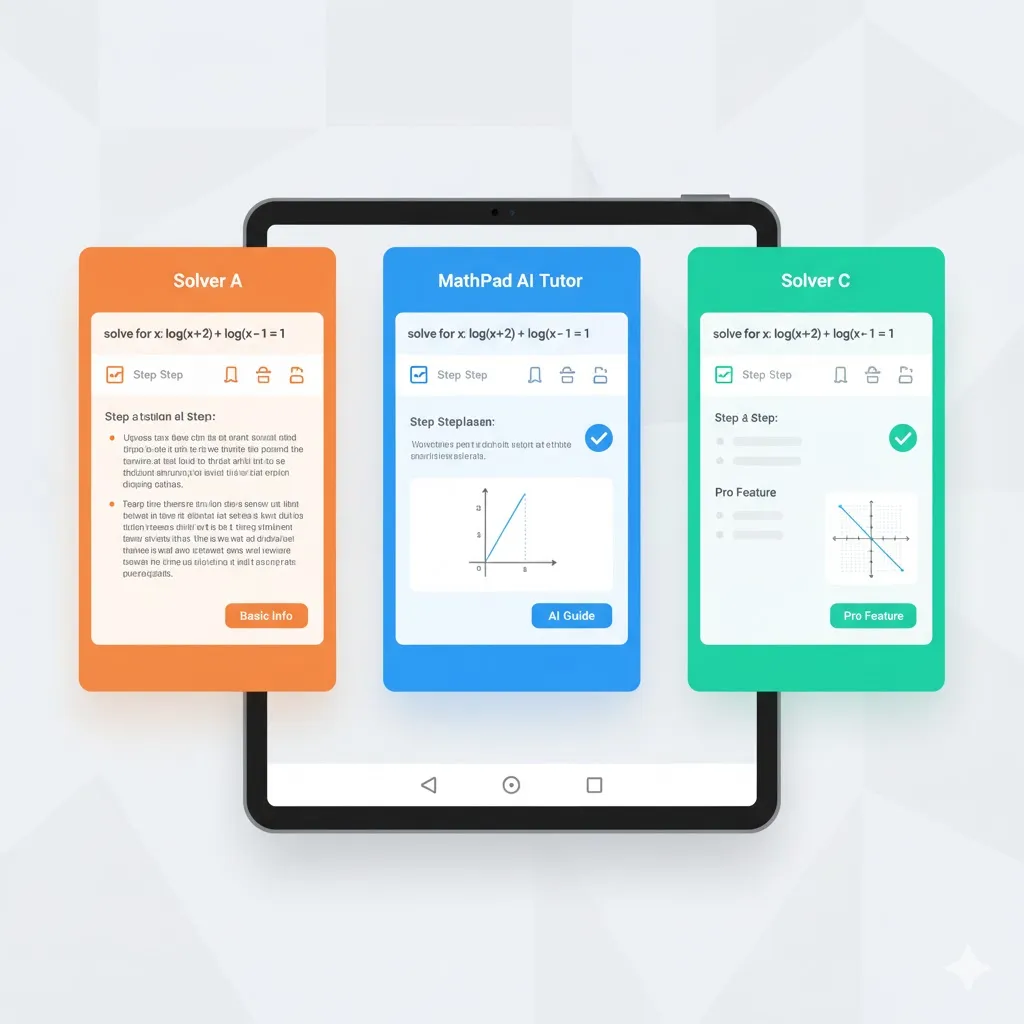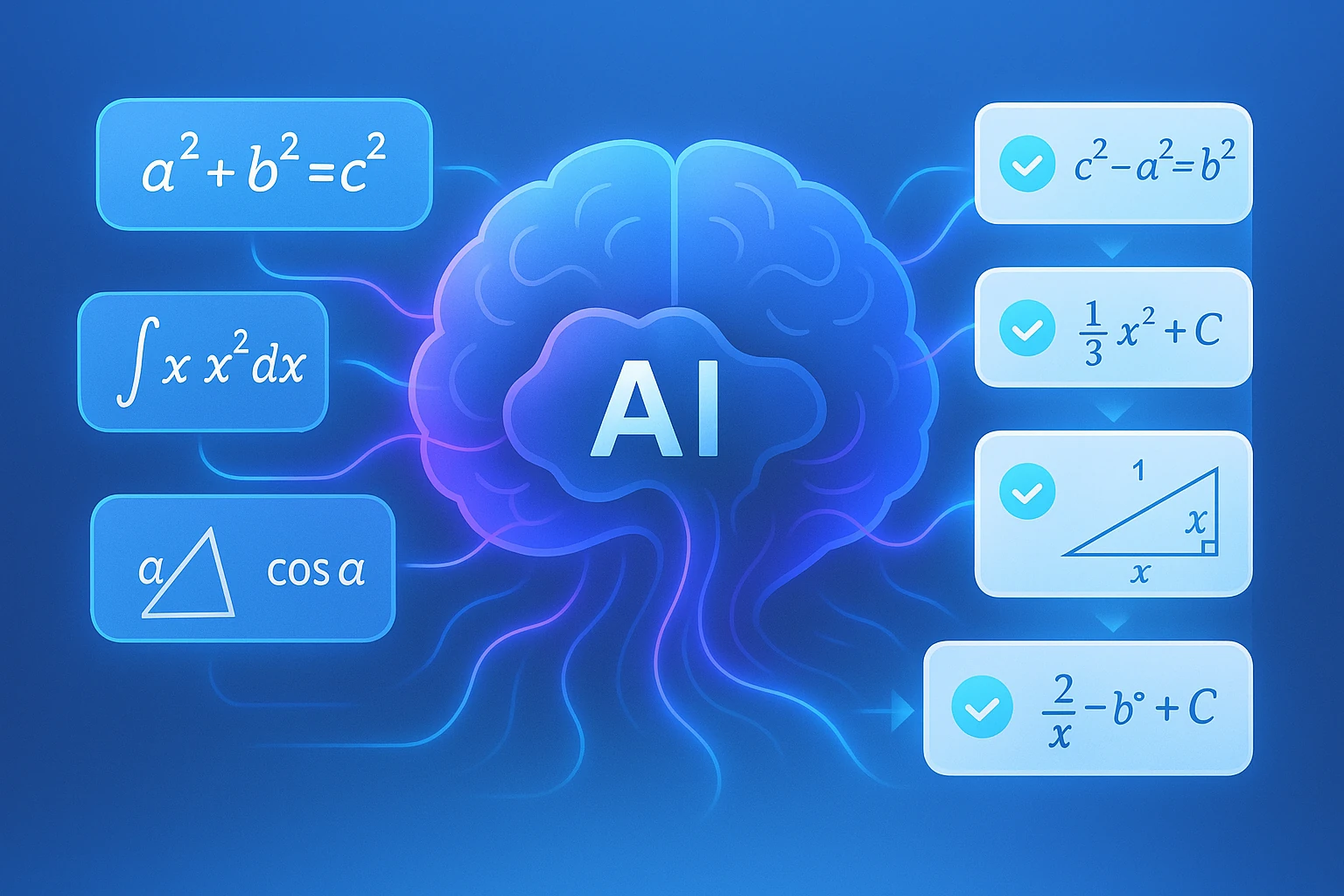ChatGPT for Math: Can AI Chatbots Actually Solve Math Problems? (2025)
ChatGPT broke the internet in late 2022. Everyone's first question: "Can it do my math homework?"
Short answer: Sometimes. ✅
Long answer: It's way more complicated than that. 🤔
Here's the truth: ChatGPT is amazing at explaining math concepts, but it can confidently give you wrong answers to actual problems. And you won't know it's wrong unless you verify it elsewhere.
This guide provides an honest assessment of what ChatGPT can and can't do for math, why large language models (LLMs) struggle with mathematical accuracy, and when you should use specialized math tools instead.
Spoiler: For learning concepts, ChatGPT is excellent. For solving homework problems accurately, you need specialized tools with CAS verification.
📸 Ready to get unstuck? Try MathPad Free →
What ChatGPT CAN Do for Math ✅
Let's start with the positives—ChatGPT has genuine strengths for mathematical learning:
1. Conceptual Explanations ⭐⭐⭐⭐⭐
ChatGPT's superpower: Explaining mathematical concepts in plain English.
Examples of what works beautifully:
You: "What is a derivative?"
ChatGPT: [Gives excellent, intuitive explanation with multiple analogies]
You: "Explain the chain rule like I'm 10"
ChatGPT: [Uses real-world analogies, clear examples]
Why it excels: ChatGPT was trained on millions of educational texts, math textbooks, and explanations. It can rephrase concepts in countless ways.
Real strength: If you don't understand your teacher's explanation, ChatGPT can give you 5 different ways to think about it.
2. Problem Setup & Strategy 🎯
What it does well: Helping you figure out how to approach a problem.
Example:
You: "How do I solve this word problem about two trains?"
ChatGPT: "This is a distance-rate-time problem. Let's set up:
- Train A: distance = rate × time = 60t
- Train B: distance = 80(t-1)
- They meet when distances equal..."
Use case: Getting unstuck on strategy, not just getting the answer.
3. Code Generation for Math 💻
Surprisingly good: Converting math problems to Python/MATLAB code.
Example:
# ChatGPT can generate this:
import numpy as np
from scipy.integrate import quad
def integrand(x):
return x**2 * np.sin(x)
result, error = quad(integrand, 0, np.pi)
print(f"Integral: {result}")
Use case: Numerical computations, plotting, simulations.
4. General Mathematical Discussion 💬
Excellent for:
- "What's the history of calculus?"
- "Why do we use e in compound interest?"
- "What are real-world applications of derivatives?"
- "How does the Pythagorean theorem connect to trigonometry?"
These are conversations, not calculations—and ChatGPT handles them beautifully.
5. Simple, Common Problems ✓
For very basic, frequently-seen problems, ChatGPT usually gets it right:
- $2 + 2 = ?$ ✓ Correct
- $x + 5 = 10$, solve for $x$ ✓ Correct ($x = 5$)
- $x^2 - 5x + 6 = 0$ ✓ Usually correct ($x = 2$ or $x = 3$)
Why: Pattern matching works when it's seen the exact problem type thousands of times in training data.
What ChatGPT CAN'T Do (The Problems) ❌
Now for the hard truths—where ChatGPT fails at math:
Problem 1: Arithmetic Errors with Large Numbers 🔢
The issue: ChatGPT doesn't actually calculate—it predicts what the answer should look like.
Test this yourself:
You: "What is $23,452 \times 7,891$?"
ChatGPT: [Often gives 185,000,000 or something close but wrong]
Correct answer: $185,095,132$
Another example:
You: "What is $\frac{847}{23}$?"
ChatGPT: [Might say 36.8 or 37.2]
Correct answer: $36.826...$
Why this happens: LLMs predict the pattern of what an answer looks like, they don't perform actual arithmetic operations.
Impact: Any problem requiring multi-digit calculation is risky.
Problem 2: Symbolic Manipulation Mistakes 🧮
The issue: ChatGPT makes algebraic errors that humans wouldn't make.
Example 1: Domain Restrictions
You: "Simplify $\frac{x^2 - 4}{x - 2}$"
ChatGPT: "$x + 2$" ❌ Incomplete! (missing the other solution)
Correct: "$x + 2$, where $x \neq 2$"
Why it matters: In calculus and advanced algebra, domain restrictions are critical. ChatGPT often forgets them.
Example 2: Complex Numbers
You: "Solve $x^2 = -1$"
ChatGPT (sometimes): "No real solution exists." ❌ Missing complex solutions!
Correct: "$x = \pm i$"
The issue: ChatGPT might answer based on the most common context (real numbers only) without considering you might need complex solutions.
Example 3: Sign Errors
Integration by parts, chain rule, quotient rule—multi-step symbolic manipulation is where ChatGPT makes sign errors, forgets constants, or misapplies rules.
Problem: These mistakes look plausible, so students copy them.
Problem 3: Confident Wrong Answers 😱
The scariest part: ChatGPT doesn't say "I'm not sure." It presents wrong answers with complete confidence.
Real example:
You: "What's the derivative of $\sin(x^2)$?"
ChatGPT (wrong answer): "$\cos(x^2)$" ❌
Correct (chain rule): "$2x \cos(x^2)$" ✓
ChatGPT forgot the chain rule! But it said it confidently, with no hint of uncertainty.
Why this is dangerous:
- Student copies the wrong answer
- Submits homework / takes test
- Loses points
- Blames themselves, not the AI
The trust problem: You can't tell when ChatGPT is right vs wrong without independent verification.
Problem 4: No Self-Verification System 🔍
Critical flaw: ChatGPT doesn't check its own work.
What happens:
- ChatGPT generates an answer (using pattern prediction)
- It presents the answer confidently
- No verification step occurs
- If it's wrong, you won't know
Contrast with CAS-verified tools:
- AI generates an answer
- CAS (Computer Algebra System) verifies symbolically
- If CAS disagrees → regenerate
- Only show verified answers
Result: MathPad can say "The answer is $x = 5$" with mathematical certainty. ChatGPT can only say "The answer is probably $x = 5$ based on similar patterns I've seen."
Problem 5: LaTeX / Notation Inconsistencies 📝
Minor but annoying: ChatGPT mixes notation styles.
In one response, it might write:
- $x^2$ (LaTeX)
- x² (Unicode superscript)
- x^2 (plain text)
For students copying to homework: This creates formatting headaches.
Why Large Language Models Struggle with Math 🧠
Let's get technical (but accessible) about why ChatGPT has these issues:
The Fundamental Architecture: Prediction vs Computation
How ChatGPT actually works:
- Training: Read trillions of words from the internet, books, websites
- Learning: Build statistical patterns of which words follow which
- Generating: When you ask a question, predict the most likely next word, then the next, then the next...
For language tasks, this is brilliant:
- "The capital of France is ___" → "Paris" (seen this pattern millions of times)
- "Explain photosynthesis" → Can synthesize from many training examples
For math, this breaks down:
Pattern matching works for common problems:
- "$2 + 2 = ?$" → Seen this exact problem thousands of times → Correctly predicts "4"
Pattern matching fails for uncommon problems:
- "$23,452 \times 7,891 = ?$" → Never seen this exact problem → Guesses based on what multiplication answers look like → Wrong
Why Math is Special (and Hard for LLMs)
Math requires:
Exact answers (not "close enough")
- In language: "The dog ran through the park" vs "The canine sprinted across the park" ≈ same meaning
- In math: "$x = 5$" vs "$x = 5.01$" → Completely different, one is wrong
Logical step sequencing (strict rules, not statistical patterns)
- You can't "mostly" apply the quadratic formula
- Each step must logically follow from the previous
Symbolic manipulation (following algebraic rules exactly)
- $(x+2)(x-2) = x^2 - 4$ is always true (not "usually" true)
- Forgetting a negative sign doesn't make it "close," it makes it wrong
ChatGPT's architecture isn't designed for this kind of rigid, rule-based processing.
What Math Actually Needs: Computer Algebra Systems (CAS)
The right tool for the job:
CAS systems (SymPy, Mathematica, Maple, Maxima):
- Manipulate mathematical expressions symbolically
- Follow strict algebraic rules
- Verify each step is logically valid
- Guarantee mathematical correctness
Example: Simplifying $\frac{x^2 - 4}{x-2}$
ChatGPT approach (pattern-based):
- "I've seen this pattern before... the answer is usually $x + 2$"
- Might forget domain restriction
CAS approach (rule-based):
- Factor numerator: $(x+2)(x-2)$
- Cancel common factor: $x + 2$ ✓
- Check domain: Denominator $\neq 0$ → $x \neq 2$ ✓
- Result: "$x + 2$, where $x \neq 2$" (complete and verified)
The Hybrid Solution (How MathPad Works)
Best of both worlds:
AI Layer (like ChatGPT):
- Understand your natural language question
- Generate intuitive explanations
- Provide step-by-step reasoning
- Interactive conversation
+
CAS Layer (symbolic verification):
- Verify every mathematical statement
- Catch errors before showing you
- Guarantee accuracy
- Ensure logical consistency
=
Reliable Math Tool:
- ChatGPT's explanatory power ✓
- CAS's mathematical rigor ✓
- No hallucinations on math facts ✓
This is why MathPad doesn't give wrong answers: The CAS layer won't let it.
Real-World Tests: ChatGPT vs MathPad
Let's test both on the same problems:
Test 1: Basic Quadratic Equation
Problem: $x^2 - 5x + 6 = 0$
ChatGPT:
- Result: $x = 2$ or $x = 3$ ✓ Correct
- Method: Factoring explained clearly
- Follow-up: "Why does factoring work?" → Excellent conceptual explanation ✓
MathPad:
- Result: $x = 2$ or $x = 3$ ✓ Correct (CAS-verified)
- Method: Shows factoring AND quadratic formula (multiple approaches)
- Follow-up: AI Tutor available, same quality explanations ✓
Winner: 🤝 Tie (both handle basic problems well)
Takeaway: For simple, common problems, both tools work fine.
Test 2: Integration by Parts
Problem: $\int x e^x,dx$
ChatGPT:
- Result: Sometimes correct, sometimes makes sign errors ⚠️
- Method: Explains integration by parts process
- Verification: None—you either trust it or you don't ❌
MathPad:
- Result: $e^x(x - 1) + C$ ✓ CAS-verified correct
- Method: Full steps, explains LIATE rule for choosing $u$
- Verification: Symbolically verified before display ✓
Winner: 🏆 MathPad (verification matters for complex problems)
Takeaway: For multi-step problems, CAS verification prevents errors.
Test 3: Conceptual Question
Question: "What's the intuition behind the chain rule?"
ChatGPT:
- Multiple excellent analogies ⭐
- "Imagine Russian nesting dolls..."
- "Think of a speedometer in a moving train..."
- Clear, accessible explanations ✓
MathPad AI Tutor:
- Similarly excellent explanations ⭐
- Can immediately follow up with practice problems ✓
- Integrated with workspace for worked examples ✓
Winner: 🤝 Tie (both excel at conceptual explanations)
Takeaway: For "why" questions, both tools are excellent.
Test 4: Arithmetic Challenge
Problem: $847 \times 523 = ?$
ChatGPT:
- Result: Often wrong or close-but-wrong ❌
- Actual: $442,981$
- ChatGPT might say: $443,000$ or $442,800$ (looks right, is wrong)
MathPad:
- Result: $442,981$ ✓ CAS-verified correct
- Method: Actual computation, not pattern matching
Winner: 🏆 MathPad (arithmetic accuracy guaranteed)
Takeaway: For any calculation, use CAS-verified tools.
When to Use ChatGPT vs Specialized Math Tools
The right tool for the right job:
✅ Use ChatGPT For:
Conceptual understanding 📚
- "What is a derivative?"
- "Why does the Pythagorean theorem work?"
- "Explain the intuition behind limits"
Problem-solving strategy 🎯
- "How do I approach this word problem?"
- "Which integration technique should I try?"
- "What's the difference between these two methods?"
Explaining concepts simply 👶
- "Explain integration like I'm 10 years old"
- "Give me an analogy for the chain rule"
Generating practice problem ideas 💡
- "Give me 5 quadratic equation examples"
- "Suggest word problems for distance-rate-time"
Translating math to code 💻
- "Write Python code to solve this numerically"
- "Generate MATLAB for plotting this function"
ChatGPT's strength: Natural language understanding and explanation.
📸 Ready to get unstuck? Try MathPad Free →
✅ Use MathPad (or Specialized Tools) For:
Solving actual math problems ✏️
- Homework questions
- Practice problems
- Test preparation
Step-by-step verified solutions ✓
- Need to see the work
- Want guaranteed accuracy
- Learning the process
Homework answer checking 📝
- "Is my answer right?"
- "Where did I go wrong?"
- Photo your work → get verification
Test preparation with practice 📊
- Generate unlimited problems
- Verify solutions immediately
- Track progress over time
When accuracy matters (Always!) 🎯
- Graded assignments
- Test preparation
- Building foundational skills
MathPad's strength: Mathematical accuracy + interactive learning.
🤝 Use Both Together (Optimal Strategy):
Workflow:
- ChatGPT: "Explain integration by parts" → Get conceptual understanding
- MathPad: Solve 10 integration by parts problems → Build skill with verification
- ChatGPT: "Generate a study schedule for calculus" → Get strategic advice
- MathPad: Execute the practice using Problem Generator → Track progress
Result: ChatGPT for strategy and concepts, MathPad for execution and accuracy.
The Future: AI + CAS Hybrid Tools 🚀
Where this is all heading:
OpenAI Knows About This Problem
Current state (2025):
- OpenAI is aware ChatGPT struggles with math
- Working on improved mathematical reasoning
- Future versions may integrate CAS verification
But for now:
- ChatGPT is still pattern-based
- No built-in verification system
- Math accuracy remains a weakness
Hybrid Tools Are the Present Solution
Tools like MathPad already combine:
- AI's natural language understanding ✓
- CAS's mathematical rigor ✓
- Interactive tutoring ✓
- Practice problem generation ✓
Why wait for future ChatGPT when hybrid tools exist now?
What GPT-5+ Might Bring
Speculation (not confirmed):
- Integrated symbolic computation
- Self-verification mechanisms
- Tool-use capabilities (calling external calculators)
- Improved mathematical reasoning
Timeline: Unknown (could be 1-3+ years)
Frequently Asked Questions
Is ChatGPT good for math homework?
For concepts: Yes! ⭐
For actual problems: Risky. ⚠️
Best use: Learn the concept from ChatGPT, then solve problems with a CAS-verified tool.
Don't do this: Copy ChatGPT's answers directly to homework (it might be wrong, and you won't know).
Does ChatGPT make math mistakes?
Yes, frequently. ❌
Types of mistakes:
- Arithmetic errors (large numbers)
- Sign errors (multi-step algebra)
- Forgetting domain restrictions
- Missing special cases (complex numbers, etc.)
- Incorrect technique application
Frequency: More common as problem complexity increases.
What's the difference between ChatGPT and MathPad for math?
Architecture:
- ChatGPT: Pattern-based language model (predicts text)
- MathPad: AI + CAS hybrid (verifies symbolically)
Accuracy:
- ChatGPT: High for concepts, variable for calculations
- MathPad: CAS-verified (100% accurate for supported operations)
Interactivity:
- ChatGPT: Conversational, can discuss anything
- MathPad: Math-focused AI Tutor + practice tools
Best for:
- ChatGPT: Explaining concepts, generating ideas
- MathPad: Solving problems, homework help, test prep
Can I trust ChatGPT's math answers?
Short answer: Not without verification. ⚠️
Reality check:
- Simple, common problems (like $2 + 2$): Usually fine ✓
- Complex multi-step problems: Verify independently ❌
- Arithmetic calculations: Don't trust ❌
- Conceptual explanations: Generally trustworthy ✓
Safe approach: Use ChatGPT for understanding, verify calculations with CAS.
Why does ChatGPT get some math problems wrong?
Because it doesn't actually "do math"—it predicts text patterns.
Analogy: Imagine someone who's read millions of math books but never learned to actually calculate. They can talk about math eloquently, but when asked to compute $23,452 \times 7,891$, they guess based on what answers usually look like.
That's ChatGPT: Excellent at discussing math, unreliable at computing it.
What is CAS and why does it matter?
CAS = Computer Algebra System
Examples: SymPy, Mathematica, Maple, Maxima
What it does:
- Manipulates mathematical expressions symbolically
- Follows strict algebraic rules
- Verifies logical consistency
- Guarantees mathematical correctness
Why it matters for students:
- Wrong information is worse than no information
- Building on errors creates compounding confusion
- Lost points on homework/tests from AI mistakes
CAS verification = confidence your answer is actually correct.
Should I use ChatGPT or a math solver app?
Depends on what you need:
Use ChatGPT if:
- Understanding a concept
- Need different explanations
- Strategic advice
- Generating ideas
Use a math solver (like MathPad) if:
- Solving homework problems
- Need verified accuracy
- Building skills through practice
- Test preparation
Optimal: Use both for different purposes.
Can ChatGPT explain math concepts?
Yes! This is what it does best. ⭐⭐⭐⭐⭐
ChatGPT excels at:
- Breaking down concepts
- Multiple explanations
- Analogies and examples
- Connecting ideas
- Simplifying complex topics
Use ChatGPT for: "What does this mean?" and "Why does this work?"
Will ChatGPT get better at math?
Probably, but it's complicated.
Challenges:
- Fundamental architecture (pattern prediction) isn't designed for exact calculation
- Would require integrating external computational tools
- OpenAI is working on it, but timeline unclear
For now: Use specialized tools for math, ChatGPT for concepts.
How do I use ChatGPT and math tools together?
Optimal workflow:
1. Conceptual Phase (ChatGPT):
- "Explain the concept to me"
- "Give me the intuition"
- "Why does this method work?"
2. Practice Phase (MathPad):
- Generate practice problems
- Solve with CAS verification
- Use AI Tutor for specific questions
- Build fluency
3. Strategy Phase (ChatGPT):
- "Create a study schedule"
- "What topics should I review?"
- "How do I prepare for the test?"
4. Execution Phase (MathPad):
- Execute the practice plan
- Track progress
- Verify all work
Result: ChatGPT's breadth + MathPad's accuracy = optimal learning.
✨ Start solving smarter Try Free →
Related Topics
Continue your learning journey:
- AI Math Tutor: How AI Teaches You Math → – Deep dive into specialized AI tutoring with CAS verification
- Math Homework Help: Complete Guide → – Full workflow for getting unstuck ethically
- PhotoMath vs Mathway vs MathPad: Best Math Solver? → – Compare specialized math tools
- Wolfram Alpha Alternative for Students → – Student-friendly computational tools
- Math Problem Generator: Unlimited Practice → – Build mastery through CAS-verified practice
- Explore MathPad's Accuracy Guarantee → – How CAS verification prevents AI hallucinations
Ready for AI math help that actually gets it right?
MathPad combines ChatGPT-style conversational AI with CAS verification—so you get intuitive explanations AND guaranteed mathematical accuracy. No more wondering "Is this answer right?"—every solution is symbolically verified before you see it.



